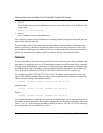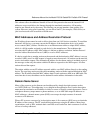
Reference Manual for the Model FVS318 Cable/DSL ProSafe VPN Firewall
Networks, Routing, and Firewall Basics B-11
Uplink Switches and Crossover Cables
In the wiring table, the concept of transmit and receive are from the perspective of the PC. For
example, the PC transmits on pins 1 and 2. At the hub, the perspective is reversed, and the hub
receives on pins 1 and 2. When connecting a PC to a PC, or a hub port to another hub port, the
transmit pair must be exchanged with the receive pair. This exchange is done by one of two
mechanisms. Most hubs provide an Uplink switch which will exchange the pairs on one port,
allowing that port to be connected to another hub using a normal Ethernet cable. The second
method is to use a crossover cable, which is a special cable in which the transmit and receive pairs
are exchanged at one of the two cable connectors. Crossover cables are often unmarked as such,
and must be identified by comparing the two connectors. Since the cable connectors are clear
plastic, it is easy to place them side by side and view the order of the wire colors on each. On a
straight-through cable, the color order will be the same on both connectors. On a crossover cable,
the orange and blue pairs will be exchanged from one connector to the other.
Cable Quality
A twisted pair Ethernet network operating at 10 Mbits/second (10BASE-T) will often tolerate low
quality cables, but at 100 Mbits/second (10BASE-Tx) the cable must be rated as Category 5, or
"Cat 5", by the Electronic Industry Association (EIA). This rating will be printed on the cable
jacket. A Category 5 cable will meet specified requirements regarding loss and crosstalk. In
addition, there are restrictions on maximum cable length for both 10 and 100 Mbits/second
networks.
Internet Security and Firewalls
When your LAN connects to the Internet through a router, an opportunity is created for outsiders
to access or disrupt your network. A NAT router provides some protection because by the very
nature of the Network Address Translation (NAT) process, the network behind the NAT router is
shielded from access by outsiders on the Internet. However, there are methods by which a
determined hacker can possibly obtain information about your network or at the least can disrupt
your Internet access. A greater degree of protection is provided by a firewall router.


















